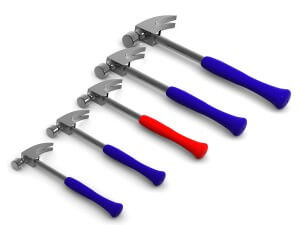 Seth Godin’s blog post yesterday was about a topic I have been thinking about a lot lately. It’s inspired by the aphorism, “…to a person with a hammer, every problem looks like a nail.”
Seth Godin’s blog post yesterday was about a topic I have been thinking about a lot lately. It’s inspired by the aphorism, “…to a person with a hammer, every problem looks like a nail.”
Some of the pain that market research is going through right now is precisely because of this. In the field of market research, we have hammers we are very comfortable with:
Full-service research offerings. Bang.
Quantitative research. Wham.
Focus Groups. Smack.
In-depth interviews. Bam.
The challenge is that the nails have morphed more quickly than our hammers. Now we have an increasing base of customers who don’t necessarily need full-service offerings. Or whose “full-service” needs are very different than what they used to be.
Still, they get whacked with the same hammer.
I also see an increasing number of nails…I mean, customer needs…that can be met with excellence using newer tools, but many long-time research suppliers are still stuck on conventional methods.
I just met a client this week who specifically shared such an experience, and how it has resulted in an “aha” moment of, “…we need to reevaluate all of our longstanding research partners to make sure they are giving us the best options.”
So for my market research agency readers, I wonder: do you have the right hammer?
And for my friends on the client-side, the fact that we are at an inflection point in terms of market research tools and applications is exactly why I recommend using RFPs these days (boy am I going to get hate mail for this!
). But truly, if you are about to engage on some important research, send an RFP to a few different agencies with a few different profiles, and see what you get back. Agencies with different sets of hammers will give you some fresh perspectives. At minimum, you will get new ideas and maybe even some education. And perhaps you will even find a proposal that truly does hit the nail on the head.










2 comments
Thanks for this post! A word about the newer “hammer” models out there – sometimes clients come to us convinced they’ve found the ideal tool – very shiny and new – but aren’t even sure about the problem (or nail) that they’re trying to hit. We’ve found that the most successful projects start with a clear identification of the research need – suppliers/internal researchers can then determine the right tool to use. We’ve had great success using some new methodologies (e.g., online qualitative), but that doesn’t mean they’re always the right tool for every problem. Sometimes a traditional method is the better way to go, but the best approach needs to carefully examine the target audience to understand the research method needed.
True, it is better to focus on one’s hammer, to be specialized. There are too many actors on the market already so better to be focus!